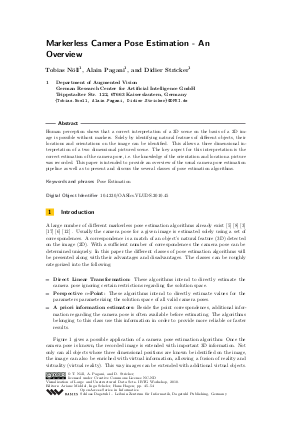Markerless Camera Pose Estimation - An Overview
Authors Tobias Nöll, Alain Pagani, Didier Stricker
-
Part of:
Volume:
Visualization of Large and Unstructured Data Sets - Applications in Geospatial Planning, Modeling and Engineering (IRTG 1131 Workshop) (VLUDS 2010)
Part of: Series: Open Access Series in Informatics (OASIcs) - License:
 Creative Commons Attribution-NonCommercial-NoDerivs 3.0 Unported license
Creative Commons Attribution-NonCommercial-NoDerivs 3.0 Unported license
- Publication Date: 2011-04-13
File

PDF
OASIcs.VLUDS.2010.45.pdf
- Filesize: 2.68 MB
- 10 pages
Document Identifiers
Subject Classification
Keywords
- Pose Estimation
Metrics
- Access Statistics
-
Total Accesses (updated on a weekly basis)
0PDF Downloads0Metadata Views
Abstract
As shown by the human perception, a correct interpretation of a 3D scene on the basis of a 2D image is possible without markers. Solely by identifying natural features of different objects, their locations and orientations on the image can be identified. This allows a three dimensional interpretation of a two dimensional pictured scene. The key aspect for this interpretation is the correct estimation of the camera pose, i.e. the knowledge of the orientation and location a picture was recorded. This paper is intended to provide an overview of the usual camera pose estimation pipeline as well as to present and discuss the several classes of pose estimation algorithms.
Cite As Get BibTex
Tobias Nöll, Alain Pagani, and Didier Stricker. Markerless Camera Pose Estimation - An Overview. In Visualization of Large and Unstructured Data Sets - Applications in Geospatial Planning, Modeling and Engineering (IRTG 1131 Workshop). Open Access Series in Informatics (OASIcs), Volume 19, pp. 45-54, Schloss Dagstuhl – Leibniz-Zentrum für Informatik (2011)
https://doi.org/10.4230/OASIcs.VLUDS.2010.45
BibTex
@InProceedings{noll_et_al:OASIcs.VLUDS.2010.45,
author = {N\"{o}ll, Tobias and Pagani, Alain and Stricker, Didier},
title = {{Markerless Camera Pose Estimation - An Overview}},
booktitle = {Visualization of Large and Unstructured Data Sets - Applications in Geospatial Planning, Modeling and Engineering (IRTG 1131 Workshop)},
pages = {45--54},
series = {Open Access Series in Informatics (OASIcs)},
ISBN = {978-3-939897-29-3},
ISSN = {2190-6807},
year = {2011},
volume = {19},
editor = {Middel, Ariane and Scheler, Inga and Hagen, Hans},
publisher = {Schloss Dagstuhl -- Leibniz-Zentrum f{\"u}r Informatik},
address = {Dagstuhl, Germany},
URL = {https://drops.dagstuhl.de/entities/document/10.4230/OASIcs.VLUDS.2010.45},
URN = {urn:nbn:de:0030-drops-30960},
doi = {10.4230/OASIcs.VLUDS.2010.45},
annote = {Keywords: Pose Estimation}
}
